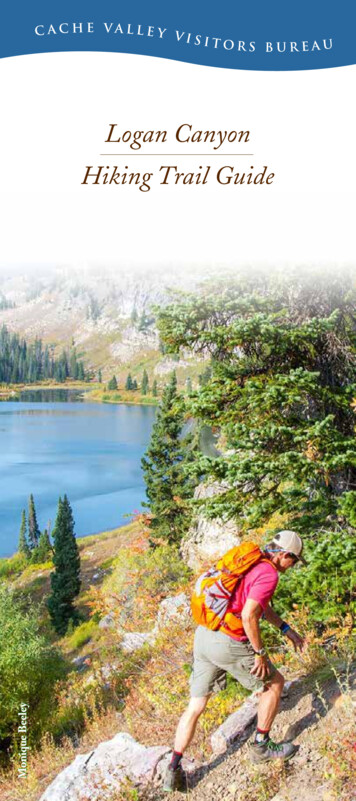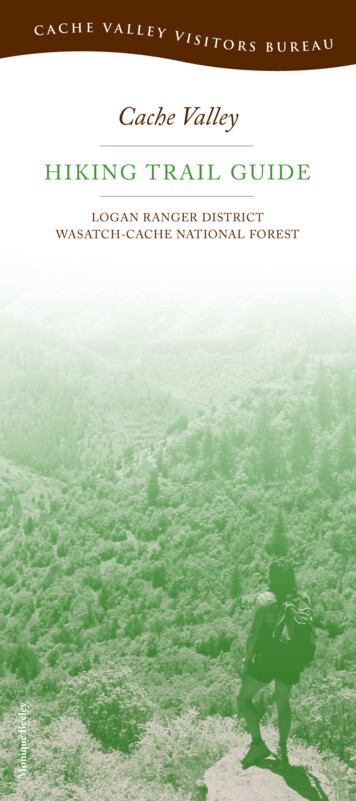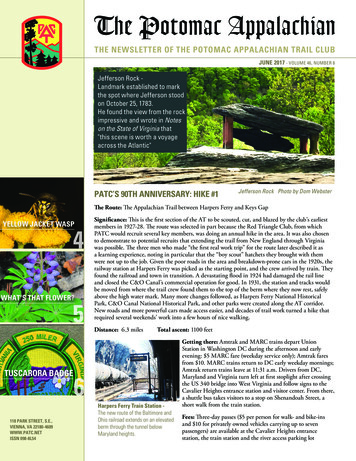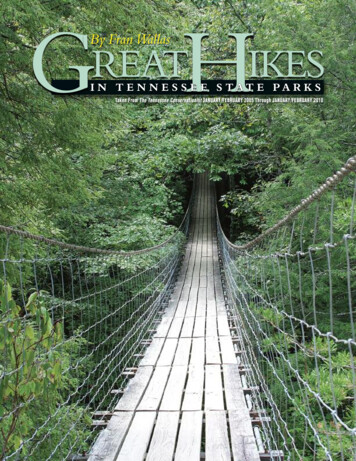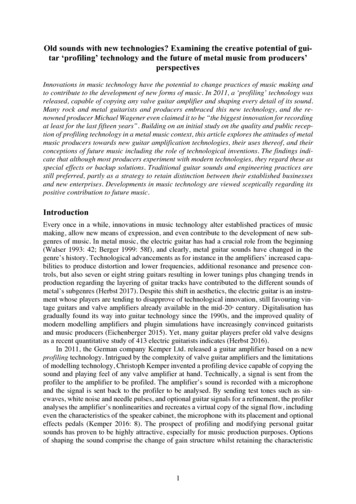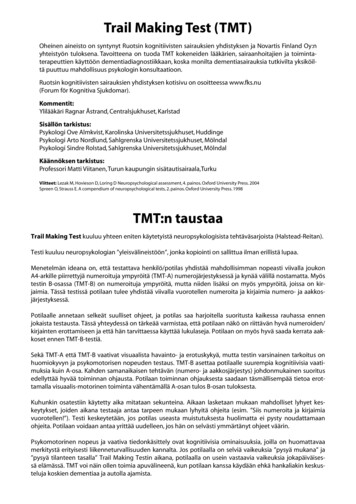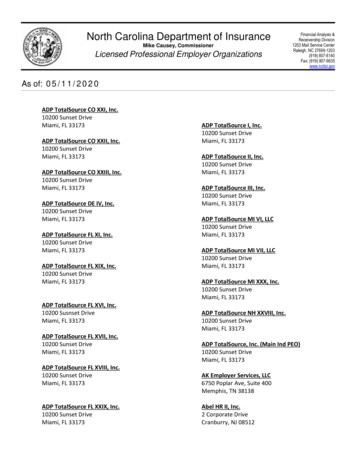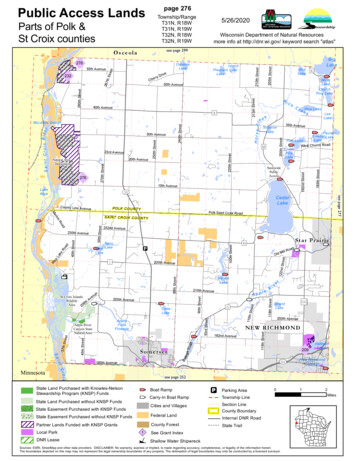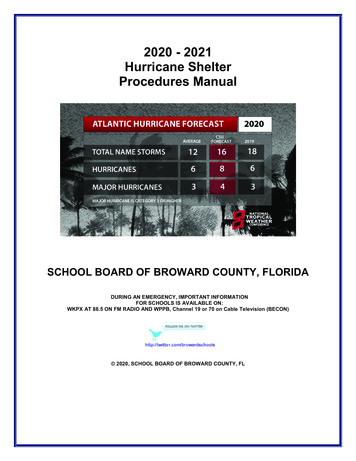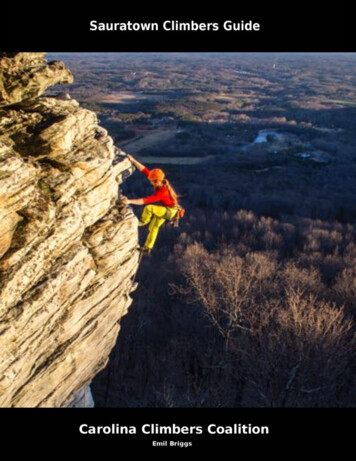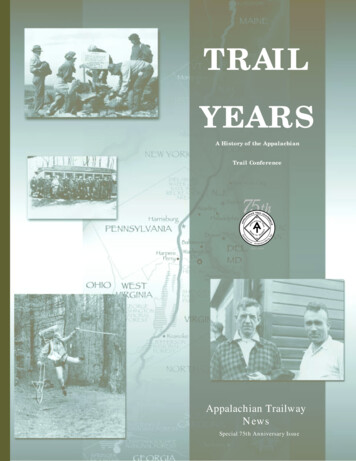
Transcription
TRAILYEARSA History of the AppalachianCH I A NTT O GEOnagETrailNIretCakersRMAGIAAPPALAILRAAPTRAIL CONIANCHFACEENERPALTrail ConferenceofA merica’siHik1925–2000Appalachian TrailwayNewsSpecial 75th Anniversary Issue
AMAINGIAPPILRAACHIAN TALE TO GEORTrail YearsBy Brian B. KingICoolidge” election. J. Edgar Hoover is shaking up the FederalBureau of Investigation he has recently been named to directBobby Kennedy, Margaret Thatcher,and is trying to manage the resurgent Ku Klux Klan, reachingits zenith of strength. Also at their zeniths are the jazz clubs ofPol Pot, and B.B. King. And television.Harlem and Chicago’s South Side.“Oscar” hasn’t been born yet, butIt’s Monday, March 2, at the grand Raleigh Hotel, whichCharlie Chaplin is working on “Thestands roughly midway between Mr. Coolidge’s White Houseand the east portico of the Capitol where Chief Justice WilliamGold Rush.” In Germany, just out ofHoward Taft will administer the oath of office on Wednesday.prison, Adolf Hitler is completing Mein KampfAt 2:15 p.m., perhaps two dozen people—mostly men, mostlyand reorganizing the Nazi party. Josef Stalin isfrom points north—sit down at the hotel in a meeting room offneutralizing Leon Trotsky. Ho Chi Minh is formthe spare but marble-appointed lobby.They have come to discuss an idea—a dream, really—thating the Vietnamese Nationalist Party. Picasso ishas caught their imagination and thatworking on his trend-breakactually appears feasible: the Appalaing “La Danse” in Paris,chian Trail. It is a work in progress, aproduct of volunteerism. To realize it,Theodore Dreiser is wrappingthey form an organization that willup An American Tragedy,become the Appalachian Trail Conferand H.L. Mencken is ravingence.In reviewing the seventy-five-yearon in Baltimore. The Unitedhistory of the organization they inauStates population is less thangurated that day, what becomes clearhalf that of today.is that it is a history of eras more thanIt’s March. The first issue of Theof personalities: first, building a conNew Yorker has just been published,tinuous Trail; second, protecting thatand the “Jazz Age” wake-up call ofTrail with a “Trailway”; third, managThe Great Gatsby is just about to be.ing and promoting that Trail as a maAl Capone takes over the Chicagojor American public recreational remob. The worst tornado in Americansource and oasis of natural easternhistory kills up to seven hundredmountain resources.people in the Midwest. TennesseeThose eras have not been mutubans the teaching of evolutionaryally exclusive periods. Instead, a crosstheory, setting the stage for one of thesection of that history might look morefirst major nonelection news eventslike a marble cake, with a particularcovered by radio, the Scopes Trial.goal growing for several years and thenIt’s the first week of March indiminishing as others grow—never(Above) The Raleigh Hotel, Washington, D.C. (TopWashington, D.C. Most of the officialcompletely vanishing. Moreover, theof page) Lobby of the hotel. (Library of Congress)side of town is absorbed with prepaorganization’s leadership, particularlyrations for the inauguration of Calvin Coolidge, who became after the pioneer period when personalities did dominate it, neverpresident when the scandal-plagued Warren Harding died in has seemed to stop asking, “What do we do next without comoffice, and who has just won the 1924 “Keep Cool with promising what we have already done?”192522000t’s 1925. Birth year of Paul Newman,
AGIAPPILRAINE TO GEORSPECIAL COMMEMORATIVE ISSUE—JULY 2000ATNLACH I A NTT O GEOnagretCakersETrailINRMAGIAAPPAAPTRAIL CONIANCHFACEENERPALAPPALACHIAN TRAILWAY NEWSILRAhe first Appalachian Trail Conference was called forthe purpose of organizing a body of workers (representative of outdoor living and of the regions adjacent to the Appalachian range) to complete the building of theAppalachian Trail. This purpose was accomplished,” say theminutes, apparently written by the New England dreamer whosegrand idea was being realized that March afternoon, BentonMacKaye.It was a time of associations and federations, all eager toimprove mankind’s lot: The Regional Planning Association ofAmerica, of which MacKaye was a member, had asked the Federated Societies on Planning and Parks to call the meeting. Thelatter was a coalition of the American Civic Association, theAmerican Institute of Park Executives and American Park Society, and the National Conference on State Parks. Its president, Frederic A. Delano, described it as “a pooling of commoninterests and not a compromise of conflicting interests,” anexplanation later used to explain the relationship between theAppalachian Trail Conference and autonomous Trail-maintaining clubs and their volunteers.MacKaye had spent most of the previous four years proselytizing in behalf of the Appalachian Trail project he had proposed in his October 1921 article in the Journal of the American Institute of Architects (see box on page 5). His essay, “AnAppalachian Trail: A Project in Regional Planning,” was classic early 20th-century American utopianism—half-pragmaticand half-philosophical, fully in keeping with the intellectualclimate of the urban East following World War I. It reacted tothe shocks of the war and the Bolshevik Revolution in Russiaand to the emerging technologies of petroleum, petrochemicals, and pharmaceuticals after nearly a century of rapid industrialization. A close reading reveals an ambitious social andpolitical agenda for an America on the post-war move, not justa hiking trail.MacKaye (pronounced “Ma-Kye,” rhyming with “sky”), alean, wiry, highly active 42-year-old Yankee’s Yankee, plainlydidn’t like where America was moving—especially by motorvehicle and especially into ever more crowded cities. He hadfirst outlined his proposal’s possibilities as a turn-of-the-century undergraduate working in what would become the East’sfirst national forest in the White Mountains of New Hampshire. He would continue that work as a graduate forestry student at Harvard University and as a land-acquisition researcherand forester under the renowned Gifford Pinchot, first chief ofthe U.S. Forest Service and a key MacKaye mentor. By the 1920s,when both he and Pinchot had been exiled from the Forest Service, he presented the Trail concept as “a new approach to theproblem of living,” a means both “to reduce the day’s drudgery” and to improve the quality of American leisure.Though MacKaye’s article clearly began the A.T. project,the idea of a long trail running along the Appalachians did notemerge overnight, in isolation.MAThe Era of Trail-Building“TACHIAN TALofA merica’siHik1925–2000Editor: Robert A. RubinCover photos—Clockwise from top: A.T. maintainers securethe first A.T. sign on Katahdin in 1935; Benton MacKaye andMyron Avery in an undated photograph from Avery’s scrapbook; frequent A.T. thru-hiker Warren Doyle adds his particularartistry to the science of measuring the Trail; A.T. supportersat the 1928 conference take a trolley excursion. Back cover:1916 Sunderland Place, shared headquarters for ATC and thePotomac Appalachian Trail Club from 1947 through 1967.Trail Years: A History of ATC,By Brian B. King The Era of Trail-Building The Era of Trail Protection The Era of Management and PromotionTrail Profiles: ATC’s Volunteer Leadership Over EightDecades Benton MacKaye and the Path to the First A.T.Conference, By Larry Anderson The Short, Brilliant Life of Myron Avery,By Robert A. Rubin Judge Perkins, in His Own Words,By Arthur Perkins Murray Stevens: A Time for Transition andConsolidation, By Robert A. Rubin Stan Murray and the Push for Federal A.T.Protection, By Judy Jenner The Last Quarter-Century: Six ConferenceChairs in an Evolving Trail Landscape,By Judy Jenner Where Now? Survey of Board Members,By Robert A. RubinTrail Work A Trail-Builder Reflects on the State of the Artafter 75 Years, By Mike DawsonTrail Notes—Along the Trail over Eight DecadesDates and Statistical Record23125217222930313339404250Appalachian Trailway News (ISSN 0003-6641) is published bimonthly, except for January/February, for 15 a year by the Appalachian Trail Conference, 799 Washington Street, Harpers Ferry, WV 25425, (304)535-6331. Bulk-rate postage paid at Harpers Ferry, WV, and other offices. Postmaster: Send change-ofaddress Form 3597 to Appalachian Trailway News, P.O. Box 807, Harpers Ferry, WV 25425.Copyright 2000, The Appalachian Trail Conference. All rights reserved.192532000
AMAINGIAPPILRAACHIAN TALE TO GEORThe Era of Trail-Building . . .Early “trampers,” Catherine E. Robbins, Hilda M. Kurth, and Kathleen M. Norris, in a 1927 brochure published by the Central VermontRailway promoting the Long Trail. Ironically, it was highways, not railways, that made access to distant trailheads possible. (ATC Archives)The first two decades of the centuryhad seen the emergence not only of forest conservation, but also of a strong hiking or “tramping” movement in New England and New York. A broad array ofpath-building efforts by small clubs inNew England and New York’s HudsonRiver valley was underway. Many whospearheaded those efforts also dreamed ofa “grand trunk“ trail, stretching the entire length of the eastern Appalachianridge lands. And, those dreamers got together from time to time.In late 1916, the New England TrailConference (NETC) met for the first timeto coordinate the work of that region’strail-making agencies and clubs. Behindthat meeting were James P. Taylor, theguiding spirit of Vermont’s Long Trail, columnist Allen Chamberlain of the BostonEvening Transcript, a hiker and past president of the Appalachian Mountain Club(AMC), and New Hampshire foresterPhilip W. Ayres, a major force behind establishment of the White Mountain National Forest.Laura and the late Guy Water192542000man, ATC members whose 1980s book,Forest and Crag, traced the history ofnortheastern trail-building, attribute thefeverish activity of this period in NewEngland and New York–New Jersey to theemergence of the automobile. It changedthe pattern of trail-building from loopsand mountain climbs centered on particular mountain vacation spots to throughtrails connecting mountain ranges—simply because hikers now could more easilytravel to other, less-developed trailheads.The “Big One”All that activity is one part ofwhat led to the A.T.—“the bigone” in eastern trail-buildingcircles—culminating many years of trailbuilders’ hopes and plans. The other is,of course, MacKaye himself. It was hisfull-length proposal that came to fruition.For MacKaye, as with any celebrateddreamer, philosopher, or grand visionary,personal history had necessarily becomeintegral to his thinking (see box, page 5).In a 1964 message to the sixteenthAppalachian Trail conference, MacKayesaid his “dream may well have originated” at the end of a hike to the peak ofVermont’s Stratton Mountain in July1900. Climbing to the top of a tree forbetter views, he wrote, “I felt as if atopthe world, with a sort of ‘planetary feeling’ . Would a footpath someday reach[far-southern peaks] from where I wasthen perched?” MacKaye in his later yearswas not consistent in his recollections ofthe source of the A.T. idea. However, hisbiographer, Larry Anderson, notes thatmost of his accounts indicate the idea didevolve to a marked extent from his turnof-the-century hikes and backcountry explorations.It would be a mistake to assume thatMacKaye was advocating a hiking utopia—although he did cast his idea interms of a footpath and he did relish theoutdoors and relatively short hikes andbackpacking trips. Yet, hiking for its ownsake, as recreation or a means to personalfulfillment, was not the goal he espoused.MacKaye’s whole work product aftercollege tells the story of a man seeking
APPILRAINAgether, they began work on the essay that MacKaye would publish inWhitaker’s Journal.“On that July Sunday half a centuryago, the seed of our Trail was planted,”MacKaye told ATC Chairman Stanley A.Murray nearly fifty years later. “Exceptfor the two men named, it would neverhave come to pass.”Why did MacKaye’s proposal take offwhen other northeasterners’ did not? Atleast for the period of the 1920s, a threepart answer can be suggested.First, MacKaye’s was a grander—andthus more inspiring—vision uncomplicated by practical, field-level details and,until later, “action plans.”Second, his article is replete withhints about the publicity value of one aspect of the proposal or another, which heintended to exploit and was encouragingsupporters to exploit as well. As his bi-GIMacKaye constructed for the rest of hislife a new, alternative family of professional associates, the men and womenwho would build the Trail, and leadingurban-life theorist Lewis Mumford. Theyalso included attorney Harvey Broome(his surrogate son, in the eyes of some)and the other conservationists withwhom he would found The WildernessSociety in the 1930s. But, more immediately, MacKaye was depressed and unproductive. His friend, editor Charles HarrisWhitaker, urged him to come to New Jersey and stay with him until he workedhis way through his grief.That summer, on Sunday, July 10,1921, MacKaye was at the Hudson GuildFarm in Netcong in the New Jersey Highlands with Whitaker to meet ClarenceStein, chairman of the committee on community planning of the Washington-basedAmerican Institute of Architects. To-MAto offset what he saw as the harm thatrapid mechanization and urbanizationinflicts on mankind. He sought regeneration of the human spirit through a sort ofharmony with primeval influences. Tohim, walking was a means to an end—anintermediate end of understanding whathe termed the “forest civilization,” whichin turn was the means of understandinghuman civilization.Then, on April 18, 1921, while inNew York City, his life took a suddenturn. MacKaye’s wife of four years—JessieBelle Hardy Stubbs, a prominent andforceful woman-suffragist the decade before—jumped to her death into the EastRiver. She had run to the bridge fromGrand Central Station, where she had justbeen at his side; they had been buyingtickets to the country where she, oftendepressed, could rest.Not having any children of his own,ACHIAN TALE TO GEORBenton MacKayeAfter Harvard, in 1905, he joined the new U.S. ForestService under Gifford Pinchot. MacKaye later recalled ameeting of the Society of American Foresters at Pinchot’sBenton MacKaye, born in 1879 in Stamford, Connecticut, washome in “about 1912” to which he read a new paper by histhe sixth child and last son of then-famous playwright, actor,friend Allen Chamberlain of AMC. “[It] was, I think, theand inventor (James) Steele MacKaye and the former Maryfirst dissertation on long-distanceEllen (Mollie) Keith Medberry, describedfootways,” he wrote.by the curator of the family’s papers asBy his early thirties, MacKaye’s“fully equal to her husband’s creativity,focusshifted from science, woodlotdaring, and flamboyance.”managementand other aspects ofFrom the time he was nine, MacKayesilviculture,tothe humanities: the effectbegan living year-round at the familyof resource management on humans. Theretreat in rural Shirley Center, Massachudiscipline that would later be calledsetts, and wandering the countryside,“regional planning” seemed best toalone or under the guidance of a neighborcapture his interests.ing farmer. His genius father was oftenIn 1920, he began a lifelong associaaway on the call of the theatre life. Hetionwith Charles Harris Whitaker, editorlost one older brother at age ten, hisoftheJournal of the American Institutefather at age fifteen.ofArchitectsand a proponent of theAt age fourteen, he began an inten“garden cities” or “new towns“ in voguesive, documented countryside explorain English planning circles that wouldtion, compiling a journal of nine “expedinot become as popular in the Unitedtions”—combining walking with investiStates until the 1960s and 1970s. Beforegation of the natural environment—onhe published his Appalachian Trailwhich a 1969 MacKaye book, Expeditionproposal, they worked together on aNine, was based.Four years later, in 1897, he had thatA young Benton MacKaye (ATC Archives) regional plan for seven Northern Tierstates that involved “new towns”first taste of wilderness he would recall asclustered near raw materials and power sources, connectedthe genesis of his A.T. notions: bicycling from Boston withto consuming towns by postal roads: a calculated use ofcollege friends to Tremont Mountain in New Hampshire andresources, with a social and economic conscience.then hiking into the backcountry. He saw it then as “a secondworld—and promise!”192552000
AMAINGIAPPILRAACHIAN TALE TO GEORThe Era of Trail-Building . . .ographer Larry Anderson has shown (seearticle on page 17), with help from formermentors, he courted reporters and columnists who would give the idea more general exposure.Third, he, Stein, and Whitaker workedtheir social and professional connectionsvigorously. A cover note by Stein on reprints of MacKaye’s article noted thefoundations already laid for a north-souththrough-trail by AMC, the Green Mountain Club, and others in the New EnglandTrail Conference, a new AMC chapter inAsheville (which became the independentCarolina Mountain Club in June 1923),the success of the Palisades InterstateParkway in New York and New Jersey,and the more utopian cooperative farmsand camps being developed in New Jersey and Pennsylvania.From 1921 to 1925, MacKaye split histime exploring two connected, but ultimately distinct roles: as the originator ofthe Appalachian Trail idea, and as one ofthe early practitioners of what would becalled “regional planning”—big-picturethinking about landscape and community. As Larry Anderson shows, his networking and persistence during this fouryear period was crucial to getting the firstconference together at the Raleigh Hotelthat Monday in March 1925.The First ConferenceThe conferees spent that first afternoon talking about the potential ofthe A.T. project, with MacKayeleading off.“Its ultimate purpose is to conserve,use, and enjoy the mountain hinterland,”he said. “The Trail (or system of trails) isa means for making the land accessible.The Appalachian Trail is to this Appalachian region what the Pacific Railwaywas to the Far West—a means of ‘opening up’ the country. But a very differentkind of ‘opening up.’ Instead of a railwaywe want a ‘trailway’ .“Like the railway, the trailwayshould be a functioning service,”192562000MacKaye continued. “It embodies threemain necessities: (1) shelter and food (aseries of camps and stores); (2) conveyance to and from the neighboring cities,by rail and motor; (3) the footpath or trailitself connecting the camps.“But, unlike the railway, the trailwaymust preserve (and develop) a certain en-Major Willam A. Welch presided over thefirst A.T. conference. (New York Times)vironment. Otherwise, its whole point islost. The railway ‘opens up’ a country asa site for civilization; the trailway should‘open up’ a country as an escape from civilization . The path of the trailwayshould be as ‘pathless’ as possible; itshould be the minimum consistent withpractical accessibility.“But, railway and trailway, each oneis a way—each ‘goes somewhere,’ MacKaye concluded. “Each has the lure of discovery—of a country’s penetration andunfolding. The hinterland we would unfold is not that from Cape to Cairo, butthat from Maine to Georgia.”The group agreed to his suggestionthat the trail-building effort be dividedinto five regions, with one or two particular sections to focus on within each. Hethought it could all be done within fifteen months, in time for the UnitedStates’ 150th anniversary.Others spoke of specific aspects’ potentials—many still resonate today.Francois E. Matthes of the U.S. Geological Survey foresaw both nature-guide andhistoric-guide services. For him, the minutes recalled, the ultimate purpose of theA.T. was “to develop an environmentwherein the people themselves (and notmerely their experts) may experience—through contact and not mere print—abasic comprehension of the forces of nature (evidence in forest growth, in waterpower, and otherwise) and of the conservation, use, and enjoyment thereof.”Fred F. Schuetz of the Scout LeadersAssociation, who would spend the rest ofhis life involved with ATC, extolled“tributary trails” from cities to theridgecrests. Arthur C. Comey, secretaryof the New England Trail Conference,gave a little workshop on “going light,”so that “the knapsack should serve as aninstrument and not an impediment in theart of outdoor living.”Clarence Stein closed that sessionwith the regional planners’ view of thesituation: “two extreme environments the city and the crestline . The further‘Atlantis’ [the growing East Coast megalopolis] is developed on the one hand, thegreater the need of developing ‘Appalachia’ on the other.”With the Trail route more advancedin New England, New York, and New Jersey, the meeting concentrated the nextmorning on the other regions. Clinton S.Smith, forest supervisor of the CherokeeNational Forest, showed the possibilitiesallowed by Forest Service trails systemsin the central and southern Appalachians,while others addressed the challenges ofa trail in the two proposed national parksand the areas between. Pennsylvania andMaryland possibilities were also addressed.The Trail’s “main line” under theplans adopted at that meeting would runan estimated 1,700 miles from Mt. Wash-
APPMomentum falters brieflyAfter the meeting, however, actual work in terms of completedTrail mileage fell off. Planningand publicity went on, carefully and indetail, but field progress—in recruitmentof volunteers and construction of Trail—lost momentum due to lack of leadership.It was as if the effort to convene the conference and to legitimatize the dreamsand grand plans had exhausted a substantial part of the energy fueling the A.T.movement—or at least the energy of itsdesignated field organizer, MacKaye. Adifferent sort of energy was required tobuild treadway.In 1926, a retired Connecticut lawyer and former police court judge namedArthur Perkins, then active with the NewEngland Trail Conference, arrived tobreathe new life into the project. By 1927,he was pressing to be appointed to fill avacancy from New England on the A.T.executive committee. In addition to Connecticut trail work, he galvanized Mas-ILRAINAsachusetts and Pennsylvania supporters and, perhaps most importantly,piqued the interest of a young lawyer whohad been associated with his Hartford lawfirm, a 27-year-old Harvard Law Schoolgraduate, Myron H. Avery (see article onpage 22).At the annual January meeting ofNETC in Boston in 1927, Perkins heardMacKaye deliver a speech entitled “Outdoor Culture: The Philosophy of ThroughTrails.” Borrowing themes developed byExecutive Committee member ChaunceyHamlin, chairman of the National Conference on Outdoor Recreation, it comesacross on paper today as a true tub-thumping political oration in behalf of the A.T.project. It certainly inspired Perkins, whoasked to hear it again later that year.American cities represent humans’tendency to “over-civilize,” MacKayeasserted. They are as “spreading, unthinking, ruthless“ as a glacier. AncientRome declined because its “Civilizees”had gone as far as they could; “the Barbarian at her back gate [gave Rome] itscleansing invasion from the hinterland.”What was needed in America was a similar invasion.MacKaye said he hoped for development of a modern American Barbarian,“a rough and ready engineer” and explorerwho would mount the crests of the Appalachians “and open war on the furtherencroachment of his mechanized Utopia . [The] philosophy of throughtrails is to organize a Barbarian invasion . Who are these modern Barbarians?”he asked. “Why, we are—the members ofthe New England Trail Conference .“The Appalachian Range should beplaced in public hands and become thesite for a Barbarian Utopia. It matters littlewhether the various sections be Statelands or Federal,” MacKaye declared,more than four decades before the Congress would agree.Later in the meeting, MacKaye, Major Welch, and Judge Perkins got together to discuss ATC business. Welch’swork in park, camp, and highway development was increasing, not only in NewYork but as a consultant to public figuresfrom presidents to industrialists and todomestic and foreign park experts. AGIvisor Verne Rhoades, who was namedvice chairman. (In the 1930s, the U.S.Forest Service chief and the National ParkService director would be honorary vicechairmen or vice presidents of ATC.)Other seats were allotted to the RegionalPlanning Association, the Federated Societies, and the National Conference onOutdoor Recreation. Comey and CharlesP. Cooper of Rutland, Vermont, heldNETC seats; Torrey and Frank Place represented the New York–New Jersey TrailConference; A.E. Rupp, chief of the statedepartment of lands and waters, and J.Bruce Byall represented the Pennsylvaniaregion; Dr. H.S. Hedges of the Universityof Virginia and G. Freeman Pollock, president of the Northern Virginia Park Association, represented their state; andRhoades and Paul M. Fink, a rustic trailblazer from Jonesboro, Tennessee, covered the rest of the South.The Appalachian Trail Conference’sfirst goal—completing the proposed footpath—was set; although it had yet to beperceived as an organization rather thana name for a meeting, its fate was forevertied to that of the Trail.MAington in New Hampshire to CohuttaMountain in Georgia. Extensions wereproposed to Katahdin in Maine, in thenorth, and, in the south, to LookoutMountain in Tennessee and then to Birmingham, Alabama. “Branch lines“ wereprojected on the Long Trail in Vermont,from New Jersey into the Catskills, fromHarpers Ferry toward Buffalo, from theTennessee River into Kentucky, and fromGrandfather Mountain in North Carolinatoward Atlanta.After a luncheon speech by NationalPark Service Director Stephen Mather, anadvocate of trails in parks, the businesspart of the meeting was called to orderby its chairman, Major William Welch ofNew York’s Palisades Interstate Park. Inshort order, the Conference was made apermanent body (although it would be almost twelve years before it would be incorporated as such) and a provisional constitution was adopted. That constitution,written by MacKaye, provided for management of ATC affairs by a fifteen-member executive committee—two from eachregion and five chosen at large.The chairmanship was awarded toWelch, who was just past the midpointof a career with the Palisades Park thatwould earn him renown as father of NewYork’s state park movement. MacKayewas elected field organizer, outdoor columnist and New York–New Jersey TrailConference advocate Raymond Torreywas appointed treasurer, and HarleanJames, already executive secretary of theFederated Societies on Planning andParks, was appointed secretary (a positionshe would hold for the next sixteen years).The composition of that initial executive committee underscores the sortof collaboration that became a key tradition of the Trail. Some have viewed it asan experiment in participatory democracy, others have called it cooperativemanagement of national resources, andstill others have described it as a uniquepartnership between the public and private sectors.In addition to the five regional divisions of the Conference, seats on the committee were specifically allocated to Col.W.B. Greeley, chief of the U.S. Forest Service, and Pisgah National Forest Super-ACHIAN TALE TO GEOR192572000
AMAINGIAPPILRAACHIAN TALE TO GEORThe Era of Trail-Building . . .man who reportedly refused all interviews clubs and the New York–New Jersey Trail and attended club meetings in New England, too. Conference scrapbooks from(in sharp contrast to MacKaye), Welch Conference.wanted to relinquish an active ATC role.With Perkins at his side much of the this period repeatedly refer to MacKayeAs a result, Perkins informally took over time, Avery, with his dual ATC/PATC as “our Nestor” (referring to the wisethe leadership of the A.T. project.positions and phenomenal dedication to old counselor of Homer’s Odyssey). BiogIn Washington, Myron Avery had the cause, set about indefatigably recruit- rapher Larry Anderson mentions that histaken a job with what eventually became ing volunteers, organizing clubs, plotting role into the mid-1930s was mostly inthe U.S. Maritime Commission. He loved routes—and flagging and cutting and con- spirational, publishing and speakingthe outdoors and was a natural leader. structing and blazing and measuring them about the idea of a wilderness trail.Avery’s concerns were more down toWithin weeks of being briefed on the A.T. and then writing construction manualsby Judge Perkins, he organized the and guidebooks, publishing them with his earth. According to a history of PATC byDavid Bates, Breaking Trail inPotomac Appalachian Trailthe Central Appalachians,Club (PATC) and was elected“Myron Avery kept a veryits first president. The lowerfirm hand on all activitiesmid-Atlantic states would bewithin the PATC. He folcome his first focus, althoughlowed all projects in detail, ofhe and Raymond Torrey bothten calling or writing to comwere concerned about Pennsylmittee chairmen to keep invania.touch or prod them along. HeA second ATC meeting,often planned the trips in evin May 1928 in Washington,ery detail.”sponsored by Avery’s new club,PATC trips during its firstformalized Perkins’ role as actfouryears resulted in the cuting chairman and authorizedting of some 265 miles of Trailrewriting of the constitutionfrom central Pennsylvania toand a more formal organizationcentral Virginia and creation offor the federation. By the nexta whole string of new A.T.year, when it was ratified inclubs south of Harpers Ferry toEaston, Pennsylvania, it inGeorgia, crucial to the complecluded the institution of a sixtion of the Trail. MacKaye laterteen-member Board of Managpraised “this vigorous club [as]ers, with a smaller executivea maker of clubs.”committee. Welch was electedAvery handled public relahon
book; frequent A.T. thru-hiker Warren Doyle adds his particular artistry to the science of measuring the Trail; A.T. supporters at the 1928 conference take a trolley excursion. Back cover: 1916 Sunderland Place, shared headquarters for ATC and the Potomac Appalachian Trail Club from 1947 through 1967. Trail Years: A History of ATC, By Brian B .
